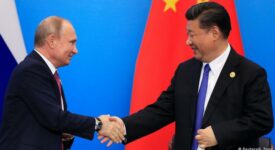US President Donald Trump has just set in motion a nightmare scenario by suddenly imposing a punitive tariff of 25% on steel imports and 10% on aluminum imports. The alleged rationale behind the move is a threat to national security – one of the most-rarely arguments used within the World Trade Organization (WTO).
Around the world, Washington’s move has provoked a series of protests and led to immediate calls for retaliation by the world’s leading economies, including the EU, Japan, Canada, and China. Who in the WTO ever thought of falling back into the drama and destructive scenarios of previous trade wars? The possibility of trade wars was traditionally to be found in economic history books – with clear lessons to avoid them at all costs – and in the field of tariff war analysis, yielding equally convincing negative results for all sides. If this is not bad enough, the impulsive nature of Donald Trump’s decision only gets across a signal of uncertainty and confusion. This decision cannot be interpreted differently than as undermining a rules-based framework.
Citing national security interest as the rationale breaks a taboo as well. Until now, this kind of explanation has restrained all WTO members from employing outright mercantilist measures since there is no “objective” way to gauge at the multilateral level what is and what is not concerning the country’s security. To elaborate, China is no longer a leading steel supplier to the US and the question is why. The answer is simple: China already suffers from a number of other measures, taming it from shipping steel to the US including anti-dumping duties and safeguard measures. It is therefore odd to impose another tariff of 25% on all suppliers, as it cannot possibly further curtail Chinese exports to the US, while this measure will likely hit many other suppliers that are not the source of dumping.
The economics and reality of this kind of war are dire. First, it is very likely that insofar any steel jobs that may be “created” in the US as a result of Trump’s punitive tariffs, the indirect effects of job losses for steel-using sectors such as construction, canning, airplanes and car manufacturing are larger. This all is under the naïve assumption that there will be no retaliatory measures. Second, retaliation is often selective, inflicting economic pain on specific regions and sectors. Third, the uncertainty and chaos resulting from this protectionism will have a cooling effect on investment and on any trade talks with the US.
The potential damage to EU steel exports to the US is very likely to be substantial. There is, however, also a secondary issue with even larger effect: other steel suppliers in the world will look for market outlets for the currently artificially uncompetitive exports to the US and the EU will very likely be one of the major recipients. The deflection of trade may take place at lower prices in an attempt to find customers in Europe that are now being supplied by others. The Commission is already seeking “safeguard measures” to protect EU member states with large steel production.
Naturally, it is still early to determine what pattern is to be expected. Yet, the new US tariff may unleash a dangerous development – a tit-for-tat trade war – and give rise to further safeguard measures not only in the EU but also elsewhere.
‘Trump’s Trade Policy Turns Destructive’ – Commentary by Jacques Pelkmans –Centre for European Policy Studies / CEPS.







